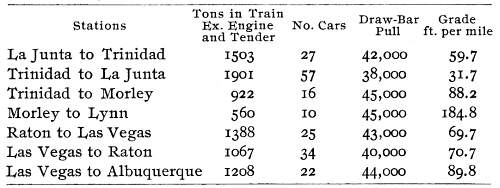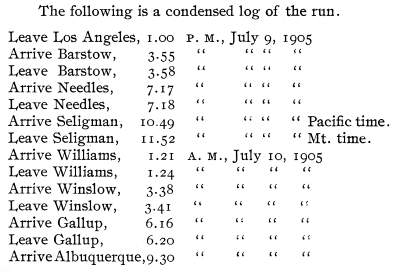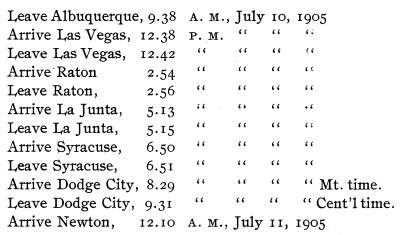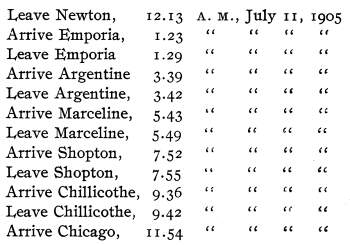Baldwin Locomotive Works
Philadelphia, Pa., U.S.A.—1906
The Atchison, Topeka and Santa Fe
Railway System
 The Atchison,
Topeka and Santa Fe Railway System occupies a prominent position
among the great railway systems of the United States. The original
company was chartered on February 11, 1859, under the name of
the Atchison and Topeka Railroad Company. This name was changed
on March 3, 1863, to Atchison, Topeka and Santa Fe Railroad Company.
The construction of the main line was begun in 1869, and the road
was opened for traffic on February 20, 1873. The original main
line extended from Atchison, Kansas, to the western boundary of
the state, and was 470.58 miles in length; the Company also operating
39.28 miles of branch lines. During the years 1874 to 1885, additional
extensions and branch lines aggregating 1357.90 miles were opened,
bringing the total length of main line and branches, on December
31, 1885, up to 1867.76 miles. The mileage of controlled roads
amounted to 878.99, the total mileage of the system thus being
2746.75 miles. The Atchison,
Topeka and Santa Fe Railway System occupies a prominent position
among the great railway systems of the United States. The original
company was chartered on February 11, 1859, under the name of
the Atchison and Topeka Railroad Company. This name was changed
on March 3, 1863, to Atchison, Topeka and Santa Fe Railroad Company.
The construction of the main line was begun in 1869, and the road
was opened for traffic on February 20, 1873. The original main
line extended from Atchison, Kansas, to the western boundary of
the state, and was 470.58 miles in length; the Company also operating
39.28 miles of branch lines. During the years 1874 to 1885, additional
extensions and branch lines aggregating 1357.90 miles were opened,
bringing the total length of main line and branches, on December
31, 1885, up to 1867.76 miles. The mileage of controlled roads
amounted to 878.99, the total mileage of the system thus being
2746.75 miles.
During the next ten years the system was rapidly extended and
additional lines were acquired. In 1895, the mileage operated
as the Atchison, Topeka and Santa Fe Railroad was 4582.12; the
total mileage in the system including controlled roads, being
9321.29. The company was in the hands of receivers at this time,
and a complete reorganization being decided upon, a new charter
was secured, under the laws of Kansas, on December 12, 1895. The
new corporation took possession of the property on January 1,
1896, under the name of The Atchison, Topeka and Santa Fe Railway
Company. Since then additional lines have been acquired by the
management. On June 30, 1904, the total mileage embraced in the
published results of operations of The Atchison, Topeka and Santa
Fe Railway Company was 8300.92; the entire length of the system,
including roads controlled or owned jointly with other companies,
being 9269.20 Miles.
A double daily service is maintained between Chicago and San
Francisco, and through sleepers are run between Chicago, Los Angeles
and San Diego. The "California Limited," (train No.
3 west bound and train No. 4 east bound), which carries first
class passengers only, takes rank as one of the finest trains
in the world. The distance from Chicago to San Francisco is 2577
miles, the actual running time for train No. 3 being seventy-six
hours fifty-five minutes, representing an average speed, including
stops, of thirty-three and five-tenths miles per hour. The road
crosses three mountain ranges, where heavy grades are encountered.
The history of the motive power of the Santa Fe System is of
peculiar interest because, since the advent of the very heavy
locomotive, this road has played a leading part in its development.
The Baldwin Locomotive Works, has been closely identified with
this development, having supplied altogether since the beginning
of the road, some 1000 locomotives. These engines have been of
various types, and a brief review of the classes represented will
prove interesting.
The first locomotives constructed at the Baldwin Locomotive
Works for the Santa Fe System were four in number. They were built
in 1875, and were of the "American type," bearing the
road numbers, 44, 45, 46 and 47. These engines were representative
of a type generally employed at that time for working all classes
of traffic. They had cylinders sixteen inches in diameter by twenty-four
inches stroke, the driving wheels being fifty-seven inches in
diameter with a wheelbase of eight feet. The total wheelbase was
twenty-one feet nine inches. The boiler was of the crown bar wagon
top type with iron shell and a steel firebox. It was forty-six
inches in diameter and contained 144 tubes, two inches in diameter
and ten feet ten and three-eighths inches long. The firebox was
sixty-four and three-quarters inches long by thirty-four and one-half
inches wide. The grate area was fifteen and seventy-four one hundredths
square feet, and the total heating surface 926 square feet. These
engines weighed about 67,000 pounds, and carried about 42,000
pounds on their driving wheels. They were furnished with eight-wheel
tenders, having wood frames and tanks of 2000 gallons capacity.
Four locomotives of similar weights and dimensions were built
in 1877 and 1878.
During the following year, 1879, thirteen engines of the same
type, but of greater power, were supplied by the Baldwin Locomotive
Works, one of them, No.
91, being illustrated on page 4. These engines had
cylinders seventeen inches in diameter by twenty-four inches stroke.
The driving wheels were fifty-seven inches in diameter with a
wheelbase of eight feet, the total wheelbase being twenty-two
feet six and one-quarter inches. The boiler was of the wagon top
type, forty-eight inches in diameter; it contained 161 tubes,
two inches in diameter by eleven feet seven and one-half inches
long. The firebox measured sixty-four and fifteen-sixteenths inches
long by thirty-four and three-eighths inches wide. The grate area
was fifteen and six-tenths square feet. The firebox heating surface
was 103 square feet, and the tube heating surface, 975 square
feet; the total thus being 1078 square feet. These engines weighed
about 73,000 pounds in working order, the weight on the driving
wheels being 47,000 pounds. The tenders were of two sizes, that
of engine No. 91 having a 2500 gallon tank. The tank capacity
of some of the engines of this class was only 2200 gallons.
At this time construction was in progress on the New Mexico
and Southern Pacific division of the line. Previous to the completion
of the tunnel at Raton Pass, near the New Mexico State line, the
mountains were crossed by a "switch back" two and three-quarters
miles long, having grades of six per cent. (316.8 feet per mile)
combined with curves of sixteen degrees. To operate on this section
of track the Baldwin Locomotive Works in 1878, built a consolidation
locomotive of exceptional power, which at that date, was the largest
engine constructed in the practice of the Works. This locomotive
bore the road number 204, and was named "Uncle Dick."
It had cylinders twenty inches in diameter by twenty-six inches
stroke; the driving wheels being forty-two inches in diameter.
With 130 pounds steam pressure the tractive power would thus be
27,400 pounds. The boiler was straight top, built of steel throughout.
It was fifty-eight inches in diameter, and contained 213 tubes,
two inches in diameter and ten feet eleven and three-quarters
inches long. The firebox was 119 and one-eighth inches long by
thirty-three and three-eighths inches wide, with a grate area
of twenty-seven and four-tenths square feet. The total heating
surface was 1376 square feet, the firebox contributing 153 square
feet, and the tubes 1223 square feet. The first and third pairs
of driving wheels had plain tires, so that while the driving wheelbase
was fourteen feet nine inches, the rigid wheelbase was but nine
feet; the total wheelbase being twenty-two feet ten inches. The
engine had a saddle tank of 1200 gallons capacity on its boiler.
As used on the road a separate tender was also provided, having
an additional capacity for 2500 gallons. The total weight of the
engine was about 115,000 pounds, of which 100,000 pounds were
carried on the driving wheels. The illustration on page 5 and the reproductions of the
drawings on pages
6 and
7, clearly show the principal features of the design.
This locomotive did efficient work, hauling on an average seven
cars weighing, loaded, 43,000 pounds each, over the six per cent.
grade; the tender weighing about 44,000 pounds additional. On
one occasion nine loaded cars were hauled. In a day of twelve
hours, the "Uncle Dick" usually moved forty-six loaded
cars over the switchback from the north to the south side, bringing
back as many in return. In comparison two "American type"
locomotives coupled together could move only thirty-four cars
each way per day, so that the Consolidation engine was more than
equal in capacity to two standard road engines, the cost for fuel
and engine service being but little more than for one American
type locomotive.
During the years 1880 and 1881, forty-five Consolidation locomotives,
built at the Baldwin Works, were added to the equipment. Fourteen
of these engines were similar in many respects to the "Uncle
Dick," having the same wheel spacing and the same size boiler.
The saddle tank was omitted; the diameter of the driving wheels
was increased to fifty inches, and the piston stroke to twenty-eight
inches. The total weight was 107,000 pounds, the weight on driving
wheels being 91,800 pounds. The tank capacity was 3200 gallons.
Engine No. 132,
illustrated on page 8, represents the class.
The remaining thirty-one Consolidation locomotives referred to
were built for the Rio Grande, Mexico and Pacific Division. They
were lighter engines having cylinders seventeen inches in diameter
by twenty-six inches stroke; the driving wheels being forty-five
inches in diameter. The total weight was about 79,000 pounds of
which the driving wheels carried about 66,000 pounds.
In 1882, fifteen American type locomotives were built, these
being the heaviest engines of this type so far delivered to the
road. Their weight being about 78,000 pounds.
During the next few years, the necessity for heavier locomotives
for passenger traffic became fully realized; and in 1886 the Baldwin
Works began the building of ten-wheel engines for this class of
service. These were large locomotives for their day, having cylinders
nineteen inches in diameter by twenty-six inches stroke and fifty-eight
inch driving wheels. The boiler was straight, sixty inches in
diameter. It contained 227 tubes, two and one-quarter inches in
diameter, and thirteen feet one and one-half inches long. The
firebox measured eighty-two and fifteen-sixteenths inches long
and thirty-four and three-eighths inches wide, the grate area
being twenty square feet. The firebox heating surface was 143
square feet, and the tube heating surface 1742 square feet; thus
giving a total of 188S square feet. The driving wheels were grouped
on a wheelbase of fourteen feet six inches, the total wheelbase
being twenty-five feet eleven and one-half inches. These engines
weighed 114,500 pounds in working order, the weight on driving
wheels being 85,400 pounds. The tank capacity was 3500 gallons.
During the ten years following 1886, upward of 100 ten-wheel
locomotives, for both passenger and freight service, were supplied
to the System, in addition to a number of six-wheel switchers
and a few eight-wheel and Consolidation engines. During this period
steam pressures gradually increased from 130 and 140 pounds to
180 pounds, and in 1894 several eight-wheel and ten-wheel engines
were built to work at 200 pounds, an unusually high pressure for
single-expansion engines at that time.
The demand for more powerful locomotives was being met, and
forty-five Consolidation engines built in 1898 were representative
of the type then employed for heavy freight service. One of these
engines is illustrated
on page 9. Particular interest attaches to this design,
as these were the first locomotives built by the Baldwin Works
to have cast steel frames, which had largely been used by John
Player, then Superintendent of Motive Power, and which were specified
by him. The builders guaranteed to replace, within a period of
two years, all frames showing defective material or workmanship,
provided such frames were made by the Standard Steel Works. Frames
furnished by other makers and accepted by the company's representative,
were not subject to the guarantee. The cylinders of these engines
were twenty-one inches in diameter by twenty-eight inches. stroke,
the driving wheels being fifty-seven inches in diameter. The boiler
contained 1905 square feet of heating surface and twenty-nine
and one-quarter square feet of grate area, and carried a steam
pressure of 180 pounds. The total weight in working order was
156,130 pounds, of which 139,530 were carried on the driving wheels.
These engines were followed, in 1900, by forty heavier locomotives
of the same type, having larger boilers and thirty-inch piston
stroke.
Fifteen ten-wheel locomotives were constructed in 1899. The
illustration
on page 10, of engine 833, shows their general features.
The frames were of cast steel. These locomotives had cylinders
twenty inches in diameter by twenty-six inches stroke, the diameter
of the driving wheels being sixty-nine inches and the steam pressure
18o pounds; thus giving them a tractive power of 23,000 pounds.
The boiler was of the wagon top type, sixty inches in diameter.
It contained 262 tubes, two inches in diameter and fourteen feet
three inches long, the firebox being 102 inches long by forty
and one-quarter inches wide. The grate area was twenty-eight and
five-tenths square feet. The heating surface of the firebox was
167, and of the tubes 1942 square feet: thus giving a total of
2109 square feet. The total weight was 155,6io pounds, the weight
on driving wheels being 120,410 pounds. The tank capacity was
5000 gallons.
In June, 1901, Mr. J. W. Kendrick accepted the position of
third vice-president of the Santa Fe System. Mr. Kendrick's wide
experience in various branches of railway work enabled him to
deal successfully with the problems which, at this time, confronted
the various operating departments and especially the question
of selecting suitable motive power for handling the constantly
increasing traffic. From this time on the weight and power of
all classes of locomotives built for the Santa Fe rapidly increased,
and the advantages of using compound locomotives were clearly
recognized. The wide firebox was introduced on road engines, the
Santa Fe thus being quick to recognize its advantages. In 1901,
the Baldwin Locomotive Works built fifty Moguls for fast freight
service, thirty-five of which were compound and fifteen single
expansion, one of the latter is illustrated on page 11 Five compound
ten-wheel passenger locomotives, having Vanderbilt boilers, designed
for burning fuel oil, were turned out at about the same time;
and were followed by forty Prairie type locomotives which were
the heaviest yet constructed for passenger service and represented
a great advance over anything heretofore built for this road.
These engines are illustrated
on page 13. During 1902 and 1903, 103 similar locomotives,
with sixty-nine inch driving wheels, were built for fast freight
service, one of which is illustrated
on page 14.
In the meantime a rapid development in the weight and power
of heavy freight locomotives was taking place. One of thirty-five
compound Consolidation engines, built in 1902, is illustrated and described on page 15.
Early in the same year the Decapod engine, illustrated on page 17, was built
and the locomotive weight-record was again broken. This was the
first tandem compound built at the Baldwin Locomotive Works. It
was followed in the latter part of 1902, by fifteen Vauclain compound
"Mikado" type engines.
The policy which has characterized the Santa Fe during recent
years, toward improvements in locomotive construction, has been
a most liberal one. Realizing the advantages possessed by the
balanced compound locomotive, the road in 1903, ordered from the
Baldwin Works four Atlantic type engines constructed on this principle.
Mr. Kendrick was chiefly responsible for the introduction of these
engines, and he has since taken a leading part in their development
and successful operation; the Santa Fe having more balanced compound
locomotives in use than any other railway in the United States.
The number built to date for this road is 137. Of these ninety-six
are Atlantic type engines which are working through express traffic
between Chicago and La Junta, Colorado. The remaining forty-one
are of the Pacific type, and are used on the mountain divisions
of the system. In order to keep the wheelbase of the latter engines
within reasonable limits, all the pistons are coupled to the second
driving axle. As the cylinders are all in the same horizontal
plane, the inside main rods are built with a loop which spans
the leading driving axle.
The successful performance of the balanced compounds on the
Santa Fe has attracted wide attention and has resulted in the
extensive use of similar engines on other roads. The Atlantic
type engines have made some particularly fine runs, and have demonstrated
their ability, when handling heavy trains, to maintain high horse-power
and sustained speed.
An illustration and description of one of the Atlantic type
engines, which was exhibited at the St. Louis Exposition is presented on page
23, while the Pacific type is illustrated on page 25. The majority
of the latter class are equipped for burning oil.
In 1903, previous to the building of the balanced compound
Pacific type locomotives, twenty-six engines of similar type,
having single-expansion cylinders with piston valves, were constructed
at the Baldwin Locomotive Works. One of these engines is illustrated on the opposite page.
The heavy Santa Fe type locomotive illustrated on page 21, is one
of 141 built since 1903. The cylinders of these engines are similar
to those of the Decapod locomotive previously mentioned. The addition
of the trailing wheels gives them better curving qualities, especially
when running backward down grades. These engines, when introduced,
were the heaviest in the world. A large number are at work on
the western divisions of the system, and are using oil as fuel.
A similar locomotive, having single-expansion cylinders twenty-four
inches in diameter, was built in 1904; but those since constructed
have all, with one exception, been fitted with tandem compound
cylinders. The exception referred to is a locomotive built in
1905, which is equipped with a smokebox superheater and single-expansion
cylinders thirty-two inches in diameter; the boiler pressure being
140 pounds. This engine was constructed for experimental purposes.
A series of tests on the hauling power of the Santa Fe locomotives
has recently been carried out, the draw-bar pull being measured
by a dynamometer car. The following table gives data secured on
the New Mexico Division. The tonnage behind the tender, number
of cars in the train, draw-bar pull and grade in feet per mile
are recorded; also the stations between which readings were taken.

With the starting valve open, the dynamometer registered as
high as 71,000 pounds draw-bar pull. This was maintained however,
for only brief periods of time.
Thirty-nine heavy six-coupled switching engines have been built
during the past year, and are illustrated
on page 27. These engines are representative of the
latest practice for this class of service. The principal dimensions
are presented with the illustration.
In building engines of various types for the same road it is
of great advantage to the builder as well as the railway company
to have the detail parts as far as possible interchangeable. In
the locomotives for the Santa Fe System, not only are the like
parts of each class accurately interchangeable, but the various
classes show a marked similarity in design and many parts are
interchangeable throughout several classes.
The Scott Special
On several occasions exceptionally rapid runs have been made
over the Santa Fe System, the most recent being that of the Scott
Special, which left Los Angeles at 1 P.M.
on July 9, 1905, and reached Dearborn Station, Chicago, at 11.54
A.M. on July 11, covering 2265 miles in
44 hours 54 minutes, actual time, including all delays. This represents
an average speed of 50.4 miles per hour, and the feat stands without
a parallel in the history of long distance running. For practically
half the distance the run was made through mountainous country,
adding enormously to the difficulties encountered. Too much credit
cannot be given the management and all the employees concerned,
for this remarkable performance.
The run was made for the accommodation of Mr. Walter Scott,
a wealthy mine owner from Death Valley, California. Mr. Scott
first proposed the trip on Saturday, July 8, and 25 hours later
the special left Los Angeles. The price paid for the run was $5500.
The train was made up, of a baggage car, a diner, and a Pullman
sleeper, together weighing 170 tons. Nineteen locomotives were
employed, manned by 18 engineers and 18 firemen. In addition,
three helper engines were employed and an extra engine hauled
the train for a short distance, owing to an accident to the regular
train engine. The train was in charge of ten conductors, and the
running was supervised by the various superintendents over whose
divisions it passed.
Of the 19 locomotives, 17 were Baldwin engines. One was a ten
wheeler, four were of the Prairie type, with Vauclain compound
cylinders, three were of the Pacific type, and nine were of the
Atlantic type, with balanced compound cylinders. The latter class
handled the train between La junta and Chicago, where the fastest
time was made. The remaining two engines were Rhode Island ten-wheelers,
similar to the Baldwin engine of the same type. In addition to
these engines, a Baldwin compound Prairie type locomotive, with
sixty-nine inch wheels, hauled the train from Kent to Newton,
a distance of twenty-six miles, on account of the accident to
the train engine referred to above. The following summary gives
a general outline of the trip, showing the distance run by each
locomotive, average speed maintained and other items of interest.
Los Angeles to Barstow.—Engine 442, Baldwin ten-wheeler
(type illustrated on page 10),
Engineer John Finlay. Distance, 141.1 miles. Time 2 hours 55 minutes.
Delayed near Upland 3 minutes, hot tender journal; San Bernardino
6 minutes, water; Cajon 4 minutes, water. Helper engine, San Bernardino
to Summit, 25.5 miles Maximum grade, 116 feet per mile. Average
speed, including Stops, 48.5 miles per hour.
Barstow to Needles.—Engine 1005, Baldwin compound
Prairie type (illustrated on page 13).
Engineer T. U. Gallagher. Distance, 169.3 miles. Time, 3 hours
19 minutes. Average speed, 51 miles per hour. Average ascending
grade, Amboy to Goffs Summit, 52.4 miles, 37.6 feet per mile.
Maximum grade, 53 feet per mile.
Needles to Seligman.—Engine 1010, Baldwin compound
Prairie type. Engineer F. W. Jackson. Distance, 148.9 miles. Time,
3 hours 31 minutes. Average speed, 42.4 miles per hour. Average
ascending grade for entire distance, 31.9 feet per mile. Maximum,
95 feet per mile.
Seligman to Williams.—Engine 1016, Baldwin compound
Prairie type. Engineer C. Woods. Distance, 50.8 miles. Time, 1
hour 29 minutes. Average speed, 34.4 miles per hour. Grades generally
ascending. Maximum, 137 feet per mile.
Williams to Winslow.—Engine 485, Rhode Island ten-wheeler.
Engineer D. A. Lenhart. Distance, 92.2 miles. Time, 2 hours 11
minutes. Average speed 42.1 miles per hour. Grades undulating.
Maximum, 95 feet per mile ascending, 75 feet descending.
Winslow to Gallup.—Engine 1000, Baldwin compound
Prairie type. Engineer J. F. Briscoe. Distance, 128 miles. Time,
2 hours 35 minutes. Average speed, 49.4 miles per hour. Grades
ascending, average for entire distance 12.9 feet per mile. Maximum,
32 feet per mile.
Gallup to Albuquerque.—Engine 478, Rhode Island
ten-wheeler. Engineer H. J. Rehder. Distance, 157.8 miles. Time
3 hours 12 minutes. Average speed, 49.4 miles per hour. Grades
undulating. Maximum, 53 feet per mile.
Albuquerque to Las Vegas.—Engine 1211, Baldwin
Pacific type (illustrated on page 19).
Engineer Ed. Sears. Distance, 132.2 miles. Time, 3 hours. Average
speed 44 miles per hour. Helper engine, Lamy to Glorieta, 9.8
miles. Delayed Lamy, 7 minutes; Glorieta, 2 minutes. Maximum ascending
grade, 158 feet per mile.
Las Vegas to Raton.—Engine 1208, Baldwin Pacific
type. Engineer G. Norman. Distance 110.8 miles. Time, 2 hours
12 minutes. Average speed, 50.5 miles per hour. Delayed Springer,
4 minutes, water. Grades undulating. Maximum, 75 feet per mile.
Raton to La Junta.—Engine 1215, Baldwin Pacific
type. Engineer H. Gardiner. Distance, 104.5 miles. Time, 2 hours
17 minutes. Average speed, 46.2 miles per hour. Helper Raton to
Trinidad, 23 miles. Maximum grade, 175 feet per mile. Delayed
Trinidad, 2 minutes; Timpas, 3 minutes, hot box on diner.
La junta to Syracuse.—Engine 536, Baldwin Balanced
compound Atlantic type (illustrated
on page 23). Engineer David Lesher. Distance, 100.8 miles.
Time, 1 hour 35 minutes. Average speed, 63.7 miles per hour. Grade
descending, average 8.2 feet per mile.
Syracuse to Dodge City.—Engine 531, Baldwin Balanced
compound. Engineer H. Simmons. Distance, 101.6 miles. Time, 1
hour 38 minutes. Average speed, 62.2 miles per hour. Grade descending,
average 7.2 feet per mile. Delayed Hartland, 5 minutes, broken
triple on engine.
Dodge City to Newton.—Engine 530, Baldwin Balanced
compound. Engineer E. Norton. No. 530 knocked out a cylinder head
at Kent. Thence to Newton, 26 miles, train was hauled by Engine
1095, Baldwin Compound Prairie type, with sixty-nine inch wheels.
Engineer Halsey. Total distance, 153.4 miles. Time, 2 hours 39
minutes. Average speed, 57.9 miles per hour. Grades generally
descending, average 6.7 feet per mile. Delayed St. John, 7 minutes,
water and oil; Kent 4 minutes, changing engines.
Newton to Emporia.—Engine 526, Baldwin Balanced
compound. Engineer H. Rossiter. Distance, 73.1 miles. Time, 1
hour 10 minutes. Average speed 62.6 miles per hour. Grades light
and generally descending.
Emporia to Argntine.—Engine 524, Baldwin Balanced
compound. Engineer J. Gossard. Distance, 120.2 miles. Time, 2
hours 10 minutes. Average speed, 57.3 miles per hour. Grades short
and undulating, track almost level, Topeka to Argentine, 62 miles.
Lost about 14 minutes owing to reduced speed through yards, etc.
Argentine to Marceline.—Engine 547, Baldwin Balanced
compound, seventy-three inch drivers. Engineer A. F. Barnes. Distance,
108 miles. Time, 2 hours 1 minute. Average speed, 54 miles per
hour.. Road generally level.
Marceline to Shopton.—Engine 542, Baldwin Balanced
compound, seventy-three inch drivers. Engineer R. Jones. Distance,
112.8 miles. Time, 2 hours 3 minutes. Average speed, 55 miles
per hour. Grades, short and undulating.
Shopton to Chillicothe.—Engine 510, Baldwin Balanced
compound. Engineer C. Losee. Distance, 104.7 miles. Time, 1 hour
41 minutes. Average speed, 62.3 miles per hour. Grades undulating;
maximum, 31.68 feet per mile.
Chillicothe to Chicago.—Engine 517, Baldwin Balanced
compound. Engineer C. Losee. Distance, 134.3 miles. Time, 2 hours
12 minutes. Average speed, 61.0 miles per hour. Delayed at South
Joliet 4 minutes on account of hot crank pin on engine. Ran slow
through Joliet yard and into Chicago. About 18 miles of ascending
grade just east of Chillicothe, maximum 26.4 feet per mile. Otherwise
line is undulating with easy grades.
Some remarkable bursts of speed were made on this trip, especially
on the eastern end where the Balanced compounds were used. The
highest speed was recorded between Cameron and Surry, 2.8 miles,
Engine 510 covering the distance in 1 minute 35 seconds, the equivalent
of 106.1 miles per hour. On descending grades in the mountain
districts, speeds exceeding 70 miles an hour were occasionally
recorded.



Contents Page
|







